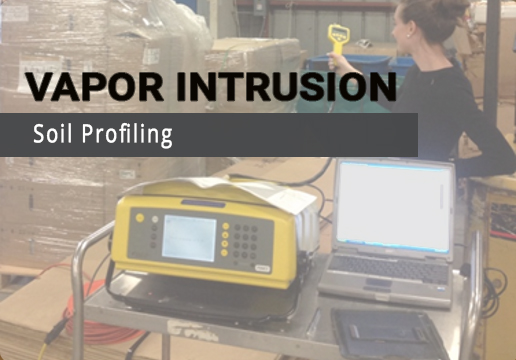This is the second in a series of posts on vapor intrusion, which refers to the migration and entry of volatile organic chemicals (VOCs) into the indoor air of buildings from underlying or nearby contaminated soil or groundwater, resulting in risk to occupant health and safety.
Our previous post on vapor intrusion (VI) focused on the benefits of real-time assessments to improve VI investigation using advanced field analytical instruments. In this post, we discuss the value of soil profiling to improve VI investigations.
Much of the regulatory guidance on VI assessment is based on collecting samples of groundwater, soil vapor, and indoor air. The results of these samples are then typically compared to screening thresholds that are supposed to indicate whether or not VI is a concern. Oftentimes, this approach is helpful in providing an initial assessment of a potential VI problem. But too frequently traditional VI assessment leaves out important data that would allow for more informed conclusions and better decisions. Reliance on conservative VI screening thresholds alone can lead to unnecessary or over-extensive VI mitigation.
The Benefits of Soil Profiling
An improved approach to VI assessment at many sites is to conduct soil profiling, which includes the collection of exterior soil samples and soil vapor samples. The benefits of this approach include:
- Better identification of the cause or source of VI, such as groundwater contamination, soil contamination, preferential pathways, or a combination
- Clearer understanding of soil conditions that are conducive to VI or that suppress VI
- Identification of key soil characteristics that can influence contaminant vapor movement, or contaminant mass flux, which is more important than contaminant concentrations alone in predicting VI
- Better definition and focus on the size/area where buildings may be affected by VI, before launching interior sampling, which can be disruptive to occupants
- Improved understanding of the potential for seasonal and longer-term variability of VI that can affect mitigation decisions
Reducing Vapor Intrusion Assessment Concerns
Soil profiling can reduce uncertainties associated with reliance on the traditional VI assessment methods. Sometimes, soil profiling can rule out a VI concern when conservative screening approaches identify a problem based on groundwater data alone. This has value in preventing unnecessary additional assessment or mitigation.
On the other hand, when soil profiling identifies or confirms a VI concern, the data obtained can be used to better focus on the problem and potential solutions. Even if a potential VI issue is identified, soil profiling and exterior soil vapor sampling can guide the scope of additional assessment and avoid unnecessary work.
The next post in this series will address another vapor intrusion assessment factor that is often overlooked: the importance and influence of building HVAC systems.
For more detailed technical information and implementation of soil profiling for improved vapor intrusion assessment, please refer to our white paper available when you complete the form below.
For over two decades, Sanborn Head has been a pioneer and first adopter of improved tools and methods for VI assessment and mitigation. Our VI practitioners have helped develop and promote advanced data collection techniques and mitigation methods through our contributions to the Interstate Technology & Regulatory Council (ITRC) VI guidance, teaching, and scores of presentations, webinars, and papers for environmental conferences and webinars. Beyond technical expertise, we provide our clients with strategic advice and solutions grounded in practical experience.
Posted In: Articles
Tagged In: Vapor Intrusion





